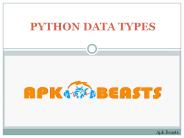Data types - PowerPoint PPT Presentation
1 / 9
Title:
Data types
Description:
Clinical chemistry, hematology, measurements. Generally a spreadsheet or export file ... TIME. take specimens of liver, blood, kidney, for archive, histopath, ... – PowerPoint PPT presentation
Number of Views:27
Avg rating:3.0/5.0
Title: Data types
1
Data types
- Microarray, etc.
- Exchange format well established
- MIAME convention, et al.
- Clinical chemistry, hematology, measurements
- Generally a spreadsheet or export file
- Terminology straightforward to harmonize
- Histopathology, observations
- Images, descriptions, spreadsheets, etc.
- Lexicons vocabulary not constrained
2
Need biological context to manage the data
- Which data came from a given subject
- When measurements were made relative to other
Study events - How and when Subjects were treated, observed,
cared for and sacrificed / exited the Study - Which Subjects are biological replicates
- Which experimental factors apply to a given
Subject - Characteristics of the Subjects and Stressors
- How well the experiment was performed
- How the data were analyzed
3
sacrifice 6, 24, 48 hr 5 animals per group
take specimens of liver, blood, kidney, for
archive, histopath, clin chem and microarray
Events on a timeline Link protocol,
group time
Organize study subjects
time
treatment euthanasia take specimen observe car
e for
- Group 48 hr, 150 mg/kg
- Comp 48 hr, 0 mg/kg
- Subject IDs, Sex
- 316 male
- 317 male
- 318 male
- male
- male
6,0
24,0
48,0
6, 50
24, 50
48, 50
dose
24, 150
48, 150
6, 150
6, 1500
24, 1500
48, 1500
4
Study Components (metadata)
- Used to describe and manage data
- Stressors
- Subjects and groups
- Timeline
- Protocols
- Study Details
5
Stressor
- Includes interventional and observational Studies
- Stressor protocols need stressor name, dose /
exposure, - frequency of dosing
- Stressor Types
- Chemical Stressor
- Environmental Stressor
- Genetic Stressor
- Disease Stressor
- Mechanical / Surgical Stressor
- Nanoparticle Stressor
6
Subjects and Groups
- Experimental Subjects
- can be lab animals, humans, in vitro cultures,
etc. - Subject Group
- group of biological replicates
- established by the experimental factors
- Specimen
- part of a Subject no longer part of the Study
timeline - can produce a subSpecimen
- Pool
- made from Specimens or subSpecimens
7
Timeline
- Linear arrangement of events that happened during
the Study, includes History - Can use either Study time or Clock time
- Link Protocol, Subject Group and Event
- Scheduled events
- planned by the PI apply to Subject Groups
- Unscheduled events
- planned by human Subjects or experienced by
Subjects in environmental studies apply to
individual Subjects - Concomitant Medication, Substance Use
8
Protocols
- Stressor application
- Each Stressor type has a protocol type
- Care
- husbandry, culture, clinical care
- Disposition
- euthanasia, harvest, study exit
- Specimen preparation and preservation
- Observation
- Assay (performed outside the Study timeline)
9
CEBS status and links
- CEBS v1.6 (microarray database w/ example
toxicity data) - http//cebs.niehs.nih.gov/
- Standardized concepts CEBS data dictionary
- http//toxsci.oxfordjournals.org/cgi/content/abstr
act/kfi315v1 - http//www.niehs.nih.gov/cebs-df/index.cfm
- ARC
- https//dir-apps.niehs.nih.gov/arc/
- register http//www.niehs.nih.gov/cebs-df/index.
cfm - CEBS v2.0 (integrated toxicogenomics database)
- In beta testing
- register http//www.niehs.nih.gov/cebs-df/index.
cfm































